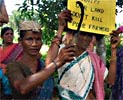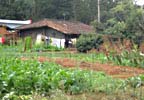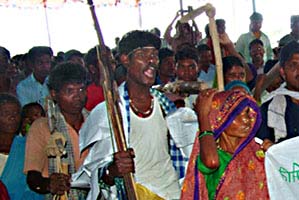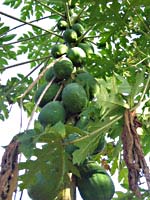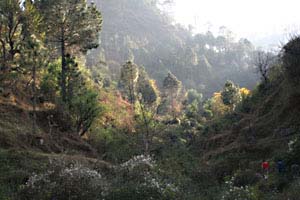Reverse Migration
Kimsar, Rajaji National Park near Rishikesh
Photos about bad road
“We need a proper road”, explains Sohan Singh Negi, headman of the village Kimsar, in the Rajaji National Park in the neighbourhood of Rishikesh. “For example, when a women has to deliver, we need to reach the hospital in the city. But in the monsoon period we cannot cross the river. The road we have is so bad, no ambulance will come to our village.” The Public Works Deartment wanted to construct a good road and even had money for it, but the Forest Department objected and went to the Supreme Court. The judges stopped the improvement of the road because it is a National Park here. Now the villagers will go to the Supreme Court to claim their road. “A simple, but good road, with a simple bridge. Then we will be connected to the city.”
Sing Negi: “The problems started more than 30 years ago. At that time the government started with the Rajaji National Park.” A big part of it is a so called ‘Reserved Forest’. It means the people have almost no rights. The Forest Department even forbid the villagers to collect leaves for fodder for the cattle. “In early days our women went to the forest to collect fodder and fire wood. Then there was less poaching, because the women were attentive. Nowadays there are many poachers and there is a lot of killing of wild animals. Villagers are the natural friends of the wildlife.” Sing Negi is sure the poachers bribe officials of the Forest Department.
According to the new Forest Act villagers who live in the forests have the right to stay there But the Forest Department tries to make their lives as difficult as possible, to push them to leave. Then they can start big tourist projects with luxury hotels.
The wild animals cause a lot of problems. In early days monkeys didn’t come to the village, because there were o lot of fruit trees and bushes in the forest. For the elephants there was a lot of bamboo. But the Forest Department cut everything, sold the bamboo and planted fast growing trees to get more money. They made from the forest a timber mine.
Another problem there is health care. There is only one health centre for the 20 villages in the National Park. The doctor never comes, because the road is too bad.
The voluntary development organisation Himcon came to the area several years ago. They started discussions with the villagers how to develop their own agriculture. People here are growing rice and millets all organic. They almost don’t need any manure because the land is very fertile. It is possible to increase farming, because 70 percent of the terasses lie fallow. But the villagers have to find a solution how to cope with the monkeys. Perhaps growing of some aromatic herbs will help. It is also possible to grow citrus fruits. Monkeys don’t like citrus. Himcon could help with nurseries to introduce grasses for fodder, fruit trees and vegetables to sell in Rishikesh to get some more income for the farmers.
But perhaps the biggest problem is not a lack of money, but the dullness of the village life for the youngsters. It would be nice when there is a cultural center. There can be a library with internet connection, and a meeting hall where you can make music and dance and have discussions. Where there can be trainings, for example about bee keeping. And with a kitchen and a place to stay for some people.
Youngsters reacted enthusiastically on the ‘dreams’ of Himcon. In fact: this is a beautiful area, with fraiche air and fertile land. When youngsters can have a nice time with their friends, certainly some of them will come back after some years of studying in the noisy, crowded, polluted city. And start rebuilding their own village life.
Himcon supports the struggle of the villagers for a good road.
This will be the first step to reverse the migration. Growing cash crops to get
more income will be another step. And perhaps the construction of a cultural center to make village
life more interesting for the youth.
Go to the next page: photo series bad road
Go to: overview articles, photos campaigns in Uttarakhand South-West
